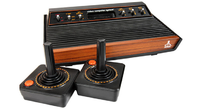North American video game crash of 1983
 | |
| North American video game crash of 1983 | |
| Impacted | Video game industry |
| Location | Primarily in the United States |
| Date(s) | 1983 - 1985 |
The North American video game crash of 1983, known in Japan as the Atari Shock (アタリショック, Atari Shokku), was a large scale recession in the video game industry, primarily in the United States of America. It occurred from 1983 until the market began to recover in 1985.
Cause
It was caused by a multitude of factors, including an over saturation of video game consoles in the first generation, due to the ubiquity of IC chips such as the General Electric AY-3-8500, and the poor reception of several video games released on the programmable ROM cartridges that followed them.
Another factor was the drop in price of computers, primarily due to a price war between Commodore International and Texas Instruments, which made them as inexpensive as video game consoles. Because computers of the time were more powerful than concurrently released video game consoles, they allowed developers to create more sophisticated games.
Recovery
After the crash, the perception of department stores toward video games was that they were a fad that ran its course. Department stores were the largest distributor of consoles prior to 1983.
To combat this, Nintendo of America designed the Nintendo Entertainment System, a localized version of the Nintendo Family Computer, to resemble a VCR. This would make it fit in within the entertainment configurations common in American homes at the time.
Nintendo of America opted to market the console in toy stores and gained a distributor in Worlds of Wonder, a toy company that had produced two top sellers in two subsequent years, which was nearly unprecedented at the time. The distributor leveraged its success in the market with the Teddy Ruxpin talking bear and Lazer Tag as an ultimatum to convince retailers to stock the NES.
To further cement its place in toy stores, Nintendo designed a toy robot called R.O.B., or Robotic Operating Buddy, which interacted with the NES.
In addition, Gail Tilden, then the head of Nintendo's advertising department, came up with the term Game Pak to avoid the term ROM cartridge in order to prevent customers being reminded of the video game crash.
To combat the oversaturation that contributed to the crash, Nintendo of America limited the amount of games companies could release per year. It also implemented a strict set of rules by which any company would have to abide to be an official licensee. This included including restricting religious symbols and violence in an attempt to market the console as family-friendly in the region. It also created the "Nintendo Seal of Quality", which would appear on the packaging and Game Pak of officially licensed products.
These efforts proved to be successful. After the release of the NES, the industry ultimately not only recovered, but the userbase expanded. By the early twenty-first century, the video game industry had become the most profitable entertainment industry in North America.